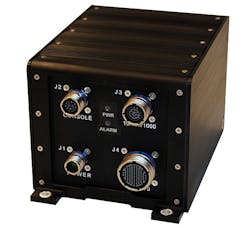Rocket designers choose R-COTS Ethernet switches from Curtiss-Wright for Atlas and Delta launch
SALT LAKE CITY, 11 April 2014. Rocket scientists at the United Launch Alliance (ULA) in Centennial, Colo., needed rugged Ethernet switches for the Atlas V and Delta IV launch vehicles. They found their solution from the Curtiss-Wright Corp. Defense Solutions division in Ashburn, Va.
Officials of the ULA -- a joint venture of Lockheed Martin Corp. and The Boeing Co. and the comanies' Atlas and Delta rockets -- awarded a $2 million contract to Curtiss-Wright for Parvus DuraNET 3000 rugged commercial off-the-shelf (R-COTS) Ethernet switches for ULA's work in the U.S. Air Force Evolved Expendable Launch Vehicle (EELV) program.
Curtiss-Wright's Parvus DuraNET 3000, an R-COTS version of the Cisco Systems IE-3000 industrial Ethernet switch, is hardened for demanding military and civil IP networking applications. ULA's launch customers include the U.S. Department of Defense (DOD), NASA, the National Reconnaissance Office, and other organizations.
The Parvus DuraNET 3000 Ethernet switches will contribute to a redundant on-vehicle local area network (LAN) used prelaunch to communicate with the flight control computer transferring pre-flight information to launch control, Curtiss-Wright officials say.
The switch routes compressed digital video off the launch vehicle. The Ethernet switch is part of ULA's common avionics initiative that seeks to use the same avionics design on Atlas and Delta rockets, which boost satellites into various Earth orbits.
Curtiss-Wright acquired Parvus Corp. in Salt Lake City last fall to boost the company's expertise in rugged small-form-factor embedded computing for military, industrial, and commercial applications. On this contract Curtiss-Wright will do the work in the company's Parvus business unit in Salt Lake City.
Parvus introduced the DuraNET 3000 ruggedized Ethernet switch in August 2011 for military and civil IP networking upgrades and military situational awareness applications that must operate in demanding environmental conditions such as ground vehicles and aircraft.
The rugged Ethernet switch comes in configurations ranging from 10, 18, or 26 Ethernet ports. The DuraNET 3000 has MIL-STD-1275 and 704 transient protection and MIL-STD-461 filtering, and is designed to MIL-STD-810. The unit operates fanlessly in temperatures from -40 to 71 degrees Celsius.
Related: Embedded computing switch for fast radar and SIGINT processing introduced by Curtiss-Wright
The Parvus DuraNET 3000 offers layer 3 IP routing services, and has mechanical enhancements to support deployment of data, video, and voice services in extreme temperatures, shock, vibration, humidity, dust, water, and electronic interference.
The Ethernet switch requires no active cooling, is sealed, and provides interfaces over MIL-C-38999 style connectors. Curtiss-Wright will ship the switches to ULA in Centennial, Colo.
For more information contact Curtiss-Wright's Parvus business unit online at www.parvus.com, Curtiss-Wright Defense Solutions at www.cwcdefense.com, or the United Launch Alliance at www.ulalaunch.com.

John Keller | Editor
John Keller is editor-in-chief of Military & Aerospace Electronics magazine, which provides extensive coverage and analysis of enabling electronic and optoelectronic technologies in military, space, and commercial aviation applications. A member of the Military & Aerospace Electronics staff since the magazine's founding in 1989, Mr. Keller took over as chief editor in 1995.

